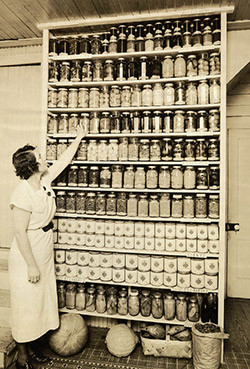 Using old-fashioned approaches can promote self-reliance during COVID-19 pandemic
Using old-fashioned approaches can promote self-reliance during COVID-19 pandemic
Paul Schattenberg, TAMU
A shortage of some consumer items and shelter-in-place restrictions due to the COVID-19 pandemic have shown the importance of traditional practices promoting self-reliance and self-sufficiency, said Texas A&M AgriLife Extension Service experts.
Sparse or empty grocery shelves, closed restaurants, a dearth of service providers and a shortage of usually easy-to-find consumer goods have led many people to search for ways to deal with these current disruptions and get back to some basics.
“People are more concerned about the quality and availability of foods these days, and getting back to some basic practices used by our grandparents can help them produce and preserve their own foods and make the most of available resources,” said Todd Swift, regional program leader for AgriLife Extension’s South Region.
Swift pointed to AgriLife Extension’s Backyard Basics initiative as a way the agency has been reintroducing Texans to practices that have been used for centuries to sustain individuals and families.
“Now that people are spending more time at home and dealing with shortages of foods like eggs and fresh vegetables, they are seeing how some time-tested practices of our forebearers can help them manage these and other challenges,” he said. “People can improve their food security and overall quality of life by using these practices to get more personal control over their lives, especially during more difficult times.”
There are some guides, publications and digital resources under the Self-Reliance tag in AgriLife Extension’s COVID-19: A hub of Extension resources page.
Here are examples of areas where people can use more traditional practices to become more directly involved in feeding and caring for their family:
Starting a backyard vegetable garden
Building raised garden beds of about 4 by 8 feet will provide a good foundation for a successful backyard garden, said David Rodriguez, AgriLife Extension horticulturist, Bexar County.
“Choose a good, sunny spot for your backyard garden,” Rodriguez said. “The three essentials for plants to grow are sun, water and soil. Establishing a garden in a north-to-south layout will provide the most sun.”
Rodriguez suggested the beginning gardener start slow by choosing four or five favorite types of vegetables and planting only a few of each type.
“Alternately planting cool- and warm-season vegetables and herbs will provide a continual harvest,” he said. “Right now, we are in warm-season vegetable mode, which is good for growing tomatoes, peppers, eggplant, squash, beans, cucumbers and the like.”
He said vegetable and herb seeds and seedlings, as well as garden soil, are available at most independent retail nurseries, and these items as well as building supplies for a raised-bed garden can be found at most large home improvement stores with a nursery.
Rodriguez said the Vegetable Resources section of the Aggie Horticulture site provides a wealth of information on vegetable variety selection, proper gardening techniques, how to address pest and disease issues, and more.
More information on how to make a successful garden and on starting a vegetable garden can be found on the AgriLife Today website.
To provide additional nourishment for vegetables and herbs, consider backyard composting. Composting enriches soil, produces beneficial bacteria, improves moisture retention, and helps suppress plant diseases and pests, reducing the need for chemical inputs. A backyard compost pile will provide continual source of supplemental nutrition for garden plants.
Preserving traditions for preserving foods
One traditional skill people may want to learn is how to preserve food they grow or purchase at the grocery store, said Connie Sheppard, Ph.D., AgriLife Extension family and community health agent, Comal County.
“Knowing how to preserve your food – in a jar or freezer – for long-term storage and use will not only save money, it will help ensure you have an adequate food supply at times when you are unable to leave your home to do your normal food shopping,” Sheppard said. “For some methods a pressure canner or other equipment may be needed, but for others it’s possible to use storage jars or other items you already have in the kitchen.”
Sheppard suggested the following resources related to food preservation and long-term storage:
• National Center for Home Food Preservation
• USDA Complete Guide to Home Canning
The Texas A&M AgriLife Bookstore also has the free downloadable publication EB-5031: Safe Home Food Storage
Tired of playing chicken with your egg supply?
One good way to avoid an egg shortage is to have your own backyard flock of chickens.
There are a variety of considerations for backyard poultry beginners. Backyard chicken flocks for beginners provides a general overview of these considerations. Additionally, AgriLife Extension and the Department of Poultry Science have a wide range of information on small-scale poultry production and backyard flocks, including publications, webinars and a list of experts.
So, you want to learn to sew?
“Both men and women can benefit from developing some simple hand-sewing skills,” said Johanna Hicks, AgriLife Extension family and community health agent for Hopkins County. “So many young people going to college these days don’t even know how to sew on a button.”
Hicks said sewing is therapeutic and a creative outlet that will allow you to save money and receive a good amount of personal satisfaction.
She said some resources for sewing basics are the 4-H Explore learning-by-doing guide and Sewing 101 video on YouTube. She said additional resources can be found in the Fashion and Interior Design section of the Texas 4-H website.
Hicks and other AgriLife Extension staffers, along with members of several agency volunteer organizations, recently put their sewing skills to use making cloth face masks for healthcare workers in several counties to help free up badly needed N95 masks for those on the front lines of the pandemic.
“Operation Face Mask and related efforts have already provided more than 500 cloth face masks locally and more than 1,000 face masks to hospitals, clinics and other healthcare facilities across the state,” she said. “It was rewarding to be able to use our sewing skills to help fill local and statewide needs at such a critical time.”
Roll out the [rain] barrel
Rainwater harvesting provides an alternative water supply and helps minimize stormwater drain-off from the roof. Harvested rainwater can be stored in rain barrels of various sizes and be used for landscape irrigation in lieu of municipal or well water.
“Making a basic 55-gallon rain barrel to capture water from gutters and downspouts to use for home landscaping isn’t very complicated, and the materials needed to build one typically cost less than $75,” said Bryan Davis, AgriLife Extension disaster assessment and recovery agent, Wilson County. “With some basic instruction and the tools and components needed, a handy person can make one in only a few hours.”
The AgriLife Extension Rainwater Harvesting page has videos on how to make a basic home rain barrel as well as links to additional rainwater harvesting resources.













